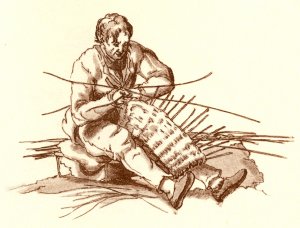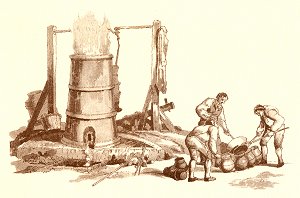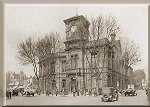








|
 |

Click to return to front page |
By Frank Sharman
EARLY INDUSTRIAL DEVELOPMENT
up to about 1790
This page is decorated with
drawings from Pyne's Microcosm of 1808. They are not
specifically of Bilston but show the kind of work that would have
been going on there in the 18th century.
Agriculture was certainly,
for centuries, Bilston’s main industry. Originally it would not
have been much more than subsistence farming but, as surpluses were
produced and an expanding economy made specialisation possible,
sales and exchanges in a market would have developed. Bilston, as
we have seen, had a market from an early date and it was centred on
the market cross. The medieval market probably served only local
needs but would have gradually expanded, though probably limited, or
at least slowed down, by the proximity of the large, regional
market, at Wolverhampton. Bilston market may have had some dealings
in wool, as wool was the mainstay of the English medieval economy.
The streets and alleys called “Folds” possible reflect this industry
but it is most likely that the major trade in Bilston wool was
through the very large wool market in Wolverhampton. On the other
hand nearly all wool eventually went through London and London
merchants and, Bilston being on the main road to London and on the
London side of Wolverhampton, it is possible that Bilston people
traded directly with passing merchants. In fact, in England
generally, far more wool was sold directly to merchants than was
sold through markets and Bilston was well placed for this sort of
trading.
 |
Brickmaking - and note the
women doing all the work here - was carried out as near
to the building site as possible. From time to
time kilns would have sprung up in various parts of
Bilston. |
 |
Basket making. Baskets
were used for all sort of thing and would, for instance,
have been far commoner than buckets. Bilston would
have been big enough by now to support all sorts of
craft workers. |
A more specialised
agricultural product was flax, which was not only grown in the
locality but processed too. The parish registers contain many
references to flax workers especially flax dressers. Presumably the
large amount of water needed for retting the flax came from the
brook. The market would also have
been a principal outlet for local artisans, of the sort which
existed in every place of any size – makers of footwear and
clothing, corn and seed merchants, carpenters and joiners, and the
like.
When other industries
started in Bilston is not clear but we know that by the 1700s
several industries had appeared and these are detailed below. But
before embarking on that it might be as well to observe that to say
that Bilston’s industries developed because there was coal, iron ore
and limestone underlying it, is not a sufficient explanation. (It
might also be pointed out that there was no very great water supply
in Bilston and that good means of transport to areas of consumption
were conspicuously lacking). In addition to the raw materials you
need knowledge and entrepreneurial skills and it must have been
those characteristics which enabled Bilston to develop
industrially. They would have been hampered by the lack of a river
for water and distribution, but perhaps helped by the fact that
there was no large landowner to hamper development by withholding
land and no guilds to stifle the widening of skills.
Dr. Rowlands says that by
the end of the 1600s it was the local gentry who were exploiting the
mineral wealth of the area: “Mr. Hoo of Bradley had a quarry of
building stone, and William Robbins of the Mansion house had a
coal-work at the Croft, where in 1692 he employed Benjamin Wood of
London to build him an engine to draw water there, which required
four men to keep it going. Samuel Pipe, esquire, had an agreement
with William Clarke, coalmaster, of Wednesbury to get coal and
iron”.
But things were changing:
by 1760 “the Hoo family had much increased their interests becoming
lords of the manors of Bradley, Barr and Wednesbury, but ceased to
reside in Bilston after 1720. The Perrys too, in their many
branches, scattered. The Pipe family died out. William Robbins
lived fifteen miles away and ‘only came over to collect his rents or
more often sent for them’. Later he moved to London. New men with
new fortunes made from new trades came to the fore. In the short
period between 1716 and 1730 when trades are given in the register
there are 240 references to buckle-makers, 61 to toy-makers and 44
to chape-makers. These trades readily adapted to the introduction
of japanning and enamelling about 1720”.
 |
Men paving (or paying) a road.
Highways were supposed to be maintained by the parish
council and every man in the village was supposed to
contribute day labour to the work. The system
worked badly. |
It might also be noted that
all of these industries, with a few exceptions such as iron
production, can be described as cottage industries, in that they
were usually run, on a small scale, by large numbers of people
operating on their own in their own houses and backyards. They
would mostly have sold their products not directly to the consumer
but to “factors”, who bought from many makers and sold the bulk of
good thus accumulated to merchants, wholesalers and retailers. If,
for instance, we think that Bilston mass produced enamelled boxes we
have to remember that this was not mass production as we know it
today, with everything being produced by a large company in a large
factory; but it was mostly a very large number of individuals and
family, each producing small quantities. But there are indications
of bigger operations, employing people outside the family, in both
enamelling and japanning.
1. Coal mining
It is well known that coal,
of high quality and in many thick seams, underlies most of Bilston.
The earliest reference to the mining of coal which Lawley gives is
one of 1315.At that time coal was not much used
for any purpose – wood was too plentiful and the making
of charcoal was widely practised. |
 |
But in time, with the near exhaustion of wood and
charcoal, coal became more and more in demand for domestic and
industrial purposes and the good people of Bilston did all they
could to meet this demand – short of working the mines efficiently.
The whole area around, and even within, the village, was covered by
small bell pits. This industry continued, to some extent at least,
until the early 20th century but most of the pits had
been worked out before then. Nearly all the mining was carried out
by one man/family operations.
2. Stone and Sand
Quarrying
 |
The first material to be
quarried in Bilston was stone for grindstones, the local stone being
of a very fine grain and producing high quality grindstones. This
work continued into the 20th century. Plott says: “The
grinding stones dug at Bilston are so fine, and of so small a grit,
that they are only useful for thin edged tools, such as knives,
razors, &c. and are better than the grinding stones brought out of
Derbyshire”. |
A second material to be
quarried was casting sand. Plott’s Natural History of Staffordshire
mentions it: “I met with a sort of sand at Bilston, so very fine
that it is hardly palpable. It is of a deep orange colour and it is
sent for by artists living at a great distance and used by them to
cast metal with”.
And the third, and
commercially most important quarry activity, was for limestone,
which was used in part for agricultural purposes, though mainly, and
more and more, as a vital flux in the making of iron and steel.
3. Buckle and chape
making
Technically a buckle
consists of two parts: the “chape” is the operative part, which
acts as a bearing for the “ring” which is the decorative part; the
ring is attached to the front of the chape to make a complete
buckle. There is no date for the start of this trade in Bilston.
It may have been there from early agricultural days and was
certainly there by the middle of the 18th century.
Although buckle makers continue to appear in the records it is chape
making which predominates and in the 18th and 19th
centuries Bilston was making many, probably most, of the chapes
which were turned into buckles in the Wolverhampton buckle making
industry. Why this industry should have developed and flourished in
Bilston is not clear but it may be derived from supplying the
buckles and other metal items which were need for the harnesses of
farm draught animals.
Chapes and buckles were made
in small family concerns who would have sold complete buckles to
factors; and chapes to Wolverhampton (and probably Walsall) buckle
makers. The Rev. Ames noted, in 1729, that his two nephews, who
were buckle makers, “began to work in the shop of my house att
Priestfields”. They seem to have worked on their own account and in
a workshop attached to the house – a typical arrangement. The
registers kept by Ames include many other references to bucklemakers.
4. Lock making
It might be worth noting
here that there was some lock making in Bilston but very little of
it. (The locks in question are security locks, not canal locks).
The trade seems to have been monopolised by Wolverhampton and
Willenhall. But some locksmiths seem to have done well. When John
Hawkesford died in 1712 he was able to include in his bequests the
sum of £5 for charitable distribution to poor widows. When his wife
died about 6 months later she left £7.10s. for the same purpose.
The first burial in the new burial ground, in 1727, was of a
locksmith, John Lees and this took place “in the presence of a large
company”.
There also seems to have
been a trade in gun locks as R. R. Angerstein gives a list of
prices: “Bilston: gunlocks, common ‘Traidel’ 15d each. Lock in
‘rest’, 6 1/2d to 7d. Wages for filing of above-mentioned locks,
6d. to 7d.”.
5. Enamelling
Enamelling was, and is, one
of Bilston’s most famous industries. Lawley says that it was
present in Bilston “well before 1750” and suggests that Dovey
Hawkesford first used enamels as a way of decorating, and adding
value to, the boxes and other small items he was making. How
Hawkesford came to be making copper boxes and other items in
Bilston, Lawley does not say. The industry soon developed and seems
to have been given a boost when workers from the Battersea factory
moved to Bilston when that factory closed. It should be noted that
the Bilston industry was not established by these workers from
Battersea, nor is it true that the Battersea work was of higher
quality than that of Bilston.
Trade remained good until
fashions changed – and some have argued that Bilston was producing
so much that enamelled wares became commonplace and therefore
unfashionable. The trade seems gradually to have disappeared during
the 19th century, though perhaps not completely.
Enamelling on larger sizes of domestic wares took place on a large
scale in Bilston in the 19th and 20th
centuries, especially after T & C Clark, the local iron founders,
discovered a way of enamelling on iron and steel. But small scale
decorative enamelling may still have been around: when Susan
Benjamin revived the trade in the late 20th century she
was able to find people in Bilston who still knew how to do it. The
crafts had many local revivals in the second half of the twentieth
century.
6. Glass
There was a glass factory,
probably producing mainly cheap bottles and window glass, at Bradley
from 1674 to 1790 but it never developed into a large industry,
Stourbridge gaining a virtual monopoly. Glasshouse Bridge remembers
the site of these works.
7. Japanning
The first reference to
japanning appears in 1710. At first it may have been wooden items
that were decorated in this way but papier mache soon replaced it
and, when thin steel sheet became readily available and cheap, that
replaced papier mache in Bilston almost entirely (though it did not
in Wolverhampton). Bilston seems to have specialised in making
blank trays for supply to Wolverhampton japanners; and finished
products of a cheaper and gaudier type than Wolverhampton’s which
are said to have been exported in large quantities to South
America. Japanning and tin plate work continued well into the 20th
century.
8. Iron and Steel
|
John Wilkinson set up in Bradley
in 1767. It was an area well supplied with
ironstone, limestone and coal, if not with water.
There may well have been small
scale iron production in the area long before Wilkinson
arrived but it is from his time that we can date this
industry which was to become the chief industry of
Bilston and the pride of the town. |
 |
Large steel works, supplying, it seems, the whole world,
started to spring up all over the area. As we will see these
eventually lessened in number until only Hickman’s was left; it
survived well into the 20th century.
 |
 |
Return to
After the Conquest |
Proceed to
18th Century Bilston |








